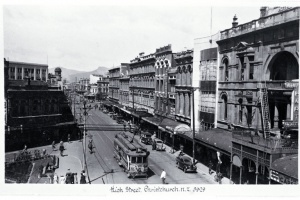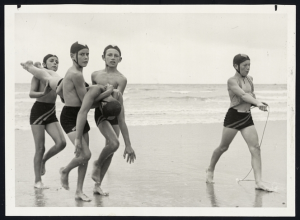(Boylove Documentary Sourcebook) - Sexual Encounters between Adult Males and Adolescent Boys in New Zealand during the Period from 1920 to 1950

From "“Waiting for Uncle Ben”: Age-Structured Homosexuality in New Zealand, 1920–1950" by Chris Brickell, in Journal of the History of Sexuality, Vol. 21, No. 3 (2012). Footnotes omitted.
Note: The author of the article has used pseudonyms and initials in order to preserve men's and youths' anonymity.
At six o’clock on a Monday evening in March 1947, Cyril Townsend met twelve-year-old David Potts in a public toilet in Christchurch, New Zealand. Townsend, a separated income tax clerk of forty-seven, recalled that Potts approached him, at which point Townsend asked “if he went with many men.” Potts volunteered that he met men in the toilets on Monday nights. According to Townsend, “He said he was waiting for ‘Uncle Ben.’ I said ‘What is Uncle Ben going to do?’ He replied ‘What the other men do.’” Needing no further clarification, the clerk asked Potts to accompany him home.
Townsend and the boy stopped at the closest fish and chip shop, picked up a feed, and wandered toward the clerk’s house. “Immediately we got inside the boy went and sat on the bed,” Townsend later explained to police. “He opened up the fly of his trousers. He took out his penis. I got hold of it and played round with it. I may have rubbed it for a while. The boy had an erection when he took his penis out. I had an erection also when I rubbed it.” At one point, Townsend recalled, Potts “discussed sexual matters with me and he said he went out with other men.” David Potts’s account of events is broadly consistent with the older man’s, and he continued the story:
He had said if I would have one before tea and one after tea. Then I said “Alright.” Then I lay down on the bed and undid the fly of my pants. He started to play with my private parts. And after a while I said I had had enough and [the] accused said we would have the fish and chips. After a while we left [the house] and I went with him to change some books at the library. I left him at the Theatre Royal. . . . I met another man the same evening after being to the place of the accused. That was about 30 minutes after being with the accused. I met this man in the same lavatory.
Subject to further questioning, Potts added: “I have been going into town like this on my own since about before Christmas. I go into town about once a week. I did not always go to the same lavatory, but usually.”
The references to police and “the accused” reveal Cyril Townsend’s fate. When David Potts returned to the toilet, he aroused the suspicions—not the desires—of the second man. This fellow asked Potts where he had been that evening and, upon hearing the lad’s story, took him to the police station. Townsend was duly reported, arrested, found guilty by a jury, and sentenced to six months in prison with hard labor. Potts, who admitted that “he has made a practice of soliciting men about the town for some time past,” was placed under state supervision.
Townsend and Potts’s story is recorded in a case file from the archives of the Christchurch Supreme Court. It evokes a landscape of cruising, wandering, hospitality, sexual activity, and subsequent state action and tells of an interaction between public and private sexual worlds. Most important for my purposes, it reveals the fleeting connection between a forty-seven-year-old man and a twelve-year-old boy. The sexualization of age differences between adult men and youths and their circumstances, meanings, and consequences are this article’s key themes. In the following pages, I use court records to explore the intricacies of age-structured homosexuality—those same-sex relations in which men take an active sexual role with boys and youths rather than adult men—in New Zealand between 1920 and 1950.
[...]
The history of sex between men and youths is a highly spatialized one. Each case file tells of males of varying ages moving through a range of private and public spaces in which they met, socialized, and had sex. Some spaces are relatively unique: a particular bedroom or backyard. Others—the main streets, parks, baths, and beachside sand dunes—turn up over and over again.
The streets of New Zealand’s cities and towns were popular places to meet. While these cities were much smaller than London, New York, or even Ottawa, there were some similarities in the uses of space. Maynard points that in Ottawa’s streets, for instance, unsupervised public boy cultures occupied the same places men cruised for sex. One New Zealand example is the North Ground, a Dunedin playing field where a “gang” of five fourteen-year-old youths loitered during the war years. This was also a well-known cruising area, and one evening in 1943 a man walked up to the boys, said “hello,” asked for a light, and offered to “suck [their] cocks.” With £1 as payment, one boy later recalled, “We all agreed to that.”
[...]
One particular pickup spot stands out. Between 1924 and 1929 four male patrons of the Christchurch Tepid Baths found themselves in the dock. Three of them met their fate at the hands of one man: Merville Lyons. Lyons was sports editor of the local Sun newspaper, chairman of the City Council’s Baths Committee, and a self-appointed moral guardian of boys. He kept a close eye on the toilets, showers, and individual changing cubicles arranged around the edges of the swimming pool. The walls and doors of these cubicles stopped several inches off the concrete floor, allowing Lyons to peer underneath and count the pairs of feet in each one.
One afternoon in 1924, Lyons burst in on William Colbert, twenty-three, and fourteen-year-old Ron Iggledun in one of the cubicles. Lyons, who noticed that “both the boy and [Colbert] had an erection,” detained the man and summoned the police. In the meantime, Colbert pleaded, “Don't get the boy into any trouble, it was my fault entirely.” Another time, Lyons waited for a toilet cubicle to become free. Eventually, Errol Dwight, a farmer of twenty-five, emerged from one of the stalls, and Lyons went in. There he found a fourteen-year-old printer’s apprentice. “His costume was down round his knees and he had an erection,” Lyons later told police, while the apprentice insisted, “We were just playing the fool together.” Dwight later confessed: “I have talked about this sort of thing with one boy before.” On the third occasion, twenty-four-year-old newspaper correspondent Jim Ogden and Jack Nimon, a fourteen-year-old youth, went into a changing cubicle, and Lyons peered under the wall from the adjacent booth. Lyons looked for an attendant and couldn’t find one, so he pushed in the door. “It was obvious,” he later told police, “that the boy had a pronounced erection.”
[...]
David Potts, who waited eagerly for “Uncle Ben” in a Christchurch toilet, had a Dunedin counterpart in James Mellor. One afternoon, fourteen-year-old Mellor lay down next to Jack Baker, a linesman in his forties, on the beach at Saint Clair. The lad struck up a conversation: “I said ‘It’s pretty windy,’ [Baker] said I had a fine body. I said ‘Yes I suppose so.’” The pair swam for a while and then retired into the lupins. There, in Mellor’s words. Baker “played with my privates and penis. After a while he took his bathing costume down and mine too. He laid on top of me and jumped up and down on me. I was lying on my stomach. He just stuck his penis into my back passage. B—was on top of me for about 15 minutes.” They were interrupted by another man who happened along and said to James, “I’ve caught you.” “Yes I know, what are you going to do about it?” the boy replied impudently, and the man decided to “put the matter in the hands of the police for the protection of other boys.” Young James argued strenuously that the law need not get involved and told anyone who would listen that nothing untoward had happened. As far as James Mellor was concerned, his sex with Jack Baker was entirely legitimate.
